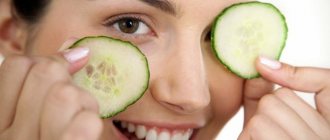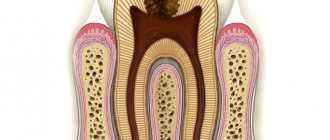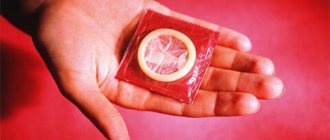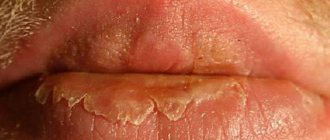Many people are familiar with such an expression as cold sore lips. It is usually used when a bubble with transparent contents forms in the lip area, which subsequently bursts and the affected area becomes covered with a crust. Cold sores are an infectious disease caused by the herpes simplex virus type 1 or 2. The source of infection can be infected people, both with and without pronounced signs of herpes. Cold on the lips is not limited to the presence of the virus only in this area. In patients herpes virus detected in body fluids such as blood (including menstrual fluid), urine, nasal discharge and tear ducts, vaginal secretions, amniotic fluid and semen. How the virus is transmitted and how to treat herpes is discussed in this article.
How does herpes infection occur?
As mentioned above, colds on the lips are caused by two types of viruses - herpes virus type 1 and herpes virus type 2 . Infection with herpes virus type 1 mainly occurs in childhood and adolescence. The main routes of transmission of infection are contact (for example, through personal objects) and airborne droplets (by inhaling the virus, kissing). However, infection can also occur through oral-genital contact. Infection with herpes virus type 2 occurs through direct sexual contact and is therefore more common among young people and adults. Transmission of pathogens of both types 1 and 2 can occur from mother to fetus (transplacentally), and also in isolated cases through infected blood products (parenterally). It is worth noting that the risk of infection increases significantly if an infected person has herpetic rashes on the skin and mucous membranes.
Herpes: symptoms, diagnosis and treatment
Itching, soreness, redness of the skin, blisters... Really again? Those who have encountered it more than once will “recognize” these symptoms as manifestations of herpes. What kind of virus is this? For what reasons does he regularly harass some people?
Our interlocutor, candidate of medical sciences, dermatovenerologist at the Expert Tula Clinic, Vladislav Leonidovich Sheinkman, told us about this and much more.
— What is herpes and how common is it among the inhabitants of our country?
This is a group of diseases caused by herpes viruses. One of the most common types is the herpes simplex virus, which is divided into herpes types 1 and 2, as well as the varicella zoster virus and herpes zoster virus.
Almost all people in Russia are infected with the herpes simplex virus. Once the virus enters the body, it never leaves it. Usually it is in the body in an inactive, “sleeping” state and does not bother a person.
— Is herpes a fungus, a virus or a bacterium?
It's a virus.
— Where does the herpes virus hide in the body?
Herpes simplex viruses are usually found in the so-called nerve ganglia (for example, in the trigeminal ganglion, sacral ganglia).
— How does infection with the herpes virus occur? Who is at risk for herpes infection?
Infection usually occurs in childhood. There are several ways of infection. This is airborne, contact household (dishes, household items, etc.), sexual.
What is immunity and how to increase it? Allergist-immunologist at Clinic Expert Smolensk tells
Chemova Ulyana Vladimirovna
The risk of virus activation occurs in the presence of so-called cofactors. These include weakened immunity, emotional distress, stress, alcohol consumption, climate change (for example, travel), menstruation, prolonged exposure to the sun or hypothermia, the presence of infection (ARVI, pneumonia, sinusitis, etc.).
Is it possible to treat sinusitis without a puncture? Otolaryngologist at the Expert Kursk Clinic, Candidate of Medical Sciences Alexandra Nikolaevna Emelyanova tells
— Tell us about the most common symptoms of herpes
Herpes occurs cyclically in the body, and its symptoms depend on the stage of the process.
The first, so-called prodromal stage, is characterized by burning, itching, and a tingling sensation in the area of future localization of herpes manifestations. The duration of this period can be several hours.
In the second stage, redness and thickening of the skin or mucous membrane appear in the form of a spot (erythematous stage). This stage of herpes lasts about a day.
At the third stage, small bubbles (2-3 mm in size) appear, which can “merge” with the serous or serous-purulent contents. Depending on the severity of the flow, the number of bubbles may vary.
In the fourth stage, the blisters break open and painful ulcers form in their place. This stage of herpes lasts several days and is the most contagious to others.
By the fifth stage, the ulcers dry out and form crusts.
And finally, at the sixth stage, the crusts fall off and the skin or mucous membrane is restored.
With type 1 herpes simplex virus, manifestations occur on the skin and mucous membranes of the upper half (for example, the lip area, nasolabial fold, neck), and type 2 - on the lower half of the body (otherwise it is called “genital herpes,” although Other areas may also be affected - for example, the buttock area, etc.).
In the recurrent form, the localization is usually stable.
— Is herpes on the lips contagious to others?
Absolutely yes.
— Does a herpetic infection always manifest itself with pronounced symptoms, or may a person not suspect that he is a carrier of the infection?
If a herpetic infection is also understood as a pure carrier state, then symptoms may not always be present. If a person has a strong immune system, he may not even know that he has such a virus.
The manifestations of exacerbation also vary from person to person. People with a normal but temporarily slightly weakened immune system, or those receiving some kind of antiviral treatment, may have a different severity of symptoms than a person with a severe illness (for example, tuberculosis), a severely weakened immune system (for example, HIV infection, chemotherapy, for organ transplants, etc.).
What are the symptoms of tuberculosis? Read more
— How is the herpes virus detected in humans?
Diagnosis of herpesvirus infection is primarily based on an examination by a dermatovenerologist.
To confirm the diagnosis, laboratory methods may be prescribed by the doctor. Some of them are used to detect the virus itself, while others are indicators of the immune response to the virus.
To search for the virus itself, polymerase chain reaction (PCR) is used, when material is taken from the site of the lesion and examined for the presence of virus nucleic acids.
An enzyme-linked immunosorbent assay (ELISA) is used to confirm the presence of an immune response against the virus. Imagine this situation. A person does not have any manifestations of herpes, and besides, he does not remember whether he ever had them or not. How to find out whether an organism has “met” the virus or not? If, when performing ELISA, specific antibodies are detected - immunoglobulins of class G (IgG) against the herpes virus, this means that there was once an infectious process, and the virus is currently in an inactive state. These antibodies are usually found throughout a person's life. If there is a suspicion of virus activation, then, in addition to PCR, an analysis for class M immunoglobulins (IgM) may be prescribed according to indications. The detection of this type of antibody indicates an exacerbation of the process. Outside of an exacerbation, only IgG is detected.
— For whom can the herpes virus be dangerous?
First of all, these are persons with serious diseases (for example, tuberculosis, oncological pathologies, immunodeficiencies). In them, the manifestation of herpes can be severe, affecting areas that are not usually found under other conditions (for example, the optic nerve).
— How to get rid of herpes? Is it enough to use only ointment or cauterize the wounds with brilliant green?
This depends on a number of factors - in particular the prevalence of the process, the frequency and severity of relapses. Often local treatment is not enough. There are certain standards and principles for the treatment of herpes, which consist in the use of antiviral drugs and agents to improve/correct the functions of the immune system.
— There are recommendations on the Internet to use tea bags or sage infusion to relieve itching from herpes. Do traditional methods really help in treating herpes infections?
The use of such methods may complicate the doctor’s work, i.e. making the correct diagnosis and prescribing effective treatment.
— What could be the consequences if herpes is not treated?
Mainly - frequent relapses, with the appearance of more common forms during exacerbations, with more severe symptoms.
— What specialty does a doctor treat herpes?
Dermatovenerologist.
You can make an appointment with a dermatovenerologist here
Please note: the service is not available in all cities
— Are effective methods of preventing herpes known to modern medicine?
Undoubtedly. It is necessary to identify and eliminate cofactors that lead to exacerbation of herpes. The main ones are stress, hypothermia or overheating, excessive alcohol intake, exposure to the sun, climate change and a number of others.
For reference:
Sheinkman Vladislav Leonidovich
Graduate of the pediatric faculty of the Smolensk State Medical Institute in 1994.
From 1994 to 1995, he completed an internship, and from 1996 to 1998, a clinical residency in the specialty “Dermatovenereology”.
Has an academic degree of Candidate of Medical Sciences.
Currently working at Clinic Expert Tula LLC as a dermatovenerologist. Provides reception at the address: st. Boldina, 74
Forms of herpetic infection
There are several forms of herpes infection. The bullous form of herpes is characterized by the appearance of blisters that can reach the size of a plum. The abortive form occurs without the formation of a blistering rash, and at the site of the lesion there is swelling and small cone-shaped elevations above the surface of the skin or mucous membranes. The most severe forms of herpes are ulcerative, ulcerative-necrotic and gangrenous. They are characterized by the appearance of vesicles with hemorrhagic contents, the appearance of long-term non-healing deep ulcers that leave scars. The development of the gangrenous form occurs in people weakened by any diseases, as well as in elderly patients with gastric ulcers, diabetes mellitus and other concomitant pathologies.
Classification and clinic of herpes
Regardless of the type, the infection manifests itself with such unpleasant symptoms as itching, tingling and a burning sensation in the area where herpetic blisters and ulcers occur.
Currently, the following types of herpes are distinguished:
- Simple or 1st type.
The inactivated virus is concentrated in the nervous system; when conditions favorable to it arise (decreased immune defense), it manifests itself in the form of skin rashes. They are small bubbles filled with a clear liquid containing thousands of viral particles. During this period, the patient is very contagious to others.
Most often, rashes appear in the area of the lips or nose, accompanied by itching and burning. After a few days, the bubbles open, exposing the erosive surface. The ulcer gradually becomes covered with a crust and disappears without a trace within 5-7 days.
- Genital or type 2.
Clinical manifestations are similar to the previous version. The main difference is the localization of the rashes. Bubbles appear in the genital area. Genital herpes affects both men and women with equal frequency, usually during puberty.
The first contact with infection can occur in three ways:
- Latent – without clinical manifestations.
- In the form of rashes on the mucous membrane of the oral cavity and nasopharynx.
- ARVI with low-grade fever, headache, weakness and malaise.
After this, the herpes virus penetrates the nervous system and can manifest itself the next time either 1 month or 10 years after the initial infection. The main factor in its activation is a decrease in immunity, which is why it is so important to carry out preventive measures.
Provocateurs of herpes infection
Colds on the lips rarely have an acute form; a chronic course of the disease is much more common. According to WHO, approximately 70% of people around the world are infected with the herpes simplex virus and about 10-20% of patients experience various symptoms of herpes infection. Exacerbations of chronic herpes occur for a number of reasons. The main factors that lead to relapse are emotional and physical stress, hypothermia, sexual intercourse, menstruation in women, concomitant diseases (ARVI, including influenza), ultraviolet radiation and others.
How are cold sores transmitted?
The herpes simplex virus is highly viable. In the external environment, at room temperature and normal humidity, it can remain active for 24 hours. HSV thrives on various surfaces, especially wet ones. It can also remain viable for several hours on coins, bills, handrails and other items we use daily. All this contributes to the high spread of the virus among people. But HSV is most easily transmitted through direct contact with damaged tissue or biological fluids of an infected person.
You can become infected with HSV-1 through airborne droplets, sexual contact, and blood transfusions. Moreover, not only the person who currently has rashes on the lips is contagious, but also asymptomatic virus carriers who may not even be aware of their infection.
Why is the herpes virus dangerous?
The herpes simplex virus affects many organs and systems. Herpetic blisters can appear on the mucous membranes of the vagina, cervix, urethra, mouth and skin, and with an extensive process they can appear in the liver and brain. Herpes can cause dysfunction of both the autonomic and central nervous systems. In addition, the herpes virus is associated with cancer, unfavorable pregnancy, childbirth, as well as pathologies in the fetus and newborns. According to the World Health Organization, the mortality rate from severe forms of the herpes simplex virus is 15.8% compared to other viral infections and ranks second after deaths from influenza (35.8%). In our country, the number of patients diagnosed with herpes infection every year exceeds 2.5 million. Patients with chronic herpetic lesions of the skin and genitals make up more than 10% of the total population of Russia.
How to quickly cure a cold on the lips at home
Since most people think herpes on the lips is a “mild” disease that does not require visiting a doctor or taking medications, treatment for colds on the lips begins with searching the Internet for traditional medicine recipes. At the same time, few people remember that modern medicine is based on evidence: medications undergo numerous clinical trials on thousands of patients, their effectiveness is assessed in the long term. And folk methods and means of treatment do not have a serious scientific basis.
Treatment of herpes on the lips with folk remedies
Any folk remedies used to treat colds on the lips can be dangerous in case of overdose, have side effects and contraindications. Folk remedies, unlike medicines, do not come with instructions where all this is described in detail. Even the most seemingly harmless infusions, lotions and decoctions from various plants and herbs can cause an allergic reaction and cause complications.
To combat herpes on the lips, it is necessary to use antiviral drugs with proven effectiveness. One of these drugs is the antiviral and immunomodulatory drug VIFERON, which includes recombinant interferon alpha-2b in combination with the antioxidant complex - tocopherol acetate (vitamin E) and ascorbic acid. The drug is available in various dosage forms for systemic (in the form of rectal suppositories) and local (ointment, gel) use.
Antiviral drug VIFERON for herpes on the lips
VIFERON has been used for several decades to treat and prevent a wide range of infections in adults and children, being the first drug in its class approved by the State Pharmaceutical Committee of the Ministry of Health of the Russian Federation for use in children, including newborns and premature babies, as well as pregnant women. The production of the drug VIFERON complies with GMP requirements. The GMP standard (Good Manufacturing Practice) are rules that establish requirements for organizing the production and quality control of medicines. In order to obtain a statement of compliance, pharmaceutical manufacturers must confirm that compliance with all norms, technologies and standards is monitored at each stage of the production process. Only in this case, in accordance with international requirements, can consumers be guaranteed high quality products.
Ointment against herpes on the lips: instructions for use
To combat colds on the face, both gel and ointment are used. The ointment has a hydrophobic base and is better absorbed on the skin, while the gel has a hydrophilic base and is better absorbed on the mucous membranes. During treatment
a strip of gel no more than 0.5 cm long is applied with a spatula or a cotton swab to a previously dried affected surface 3-5 times a day. The duration of the course of treatment is 5-6 days. If necessary, the duration of the course is increased until clinical manifestations disappear. The gel is colorless, so it does not stain clothes and is invisible on the face. It forms an imperceptible, thin film on the affected surface, so women can freely use decorative cosmetics during treatment. This is important for those who want to look great even if they have a cold on their lips. The gel can also be used from the first days of a child’s life.
The ointment is applied in a thin layer to the lesions 3-4 times a day, the duration of the course of treatment is 5-7 days. It is possible to use the drug VIFERON Ointment during pregnancy and breastfeeding. In addition, the good tolerability of the drug makes it possible to use it in children from the first year of their life.
1,000,000 IU suppositories for HSV-1 in adults are used for 10 days, in pregnant women - at a dosage of 500,000 IU for the first 10 days, then therapy continues according to the instructions.
VIFERON ointment, gel and suppositories not only fight viruses, but also improve local immunity, reducing the likelihood of a relapse[1].
Treatment of herpes
The herpes virus enters the body through the mucous membranes and settles in the nerve ganglia for life. Therefore, it is impossible to completely get rid of the pathogen. However, with proper therapy, it is possible to reduce the intensity of the rash, significantly reduce the duration of the prodromal period and reduce the frequency of exacerbations. Treatment of herpes at home includes antiviral therapy using antiherpetic drugs. But since colds on the lips are accompanied by immunodeficiency, the treatment regimen also includes immunomodulatory agents, for example, interferon preparations or its inducers. In the combined treatment of herpes, the drug Viferon can be used, which resists viruses and corrects protective functions. Using the drug in a treatment regimen allows you to quickly relieve the symptoms of herpes and prolong remission. In addition, the good tolerability of the drug makes it possible to use it in children and pregnant women.
Based on materials:
1. Malinovskaya V.V., Delenyan N.V. et al. "Viferon". Guide for doctors. M. 2004. 6. Malinovskaya V.V., Uchaikin “Viferon (suppositories and gel) in the complex therapy of herpes virus infections”, A.A. Haldin, D.V. Baskakova, A.N. Vasiliev. 2. “Algorithm for the treatment of exacerbations and secondary prevention of herpes simplex with Viferon”, A. A. Khaldin, I. V. Polesko. 3. “Algorithm for the treatment of exacerbations and secondary prevention of herpes simplex with Viferon”, Haldin A.A., Polesko I.V.
Loading...
Take other surveys
Symptoms: what a cold on the lips looks like
The incubation period for this disease lasts from 2 to 8 days. After this, characteristic symptoms appear. There are acute and chronic labial herpes.
Clinical signs of acute herpes on the lips:
- swelling, redness and itching in the red border of the lips, wings of the nose, and oral mucosa;
- the appearance at the site of inflammation of small bubbles filled with transparent contents;
- gradually the bubbles open, dry out, and in their place a crust forms, which then falls off;
- when the bubbles merge with each other, ulcers form;
- in some cases, there is a disturbance in general well-being and an increase in body temperature.
The duration of the disease is on average 10-12 days and depends on the patient’s age, immunity status and the presence of concomitant diseases.
Clinical signs of chronic herpes on the lips
Most often, herpesvirus infection has a recurrent course and periodically makes itself felt. During an exacerbation of the chronic form of the disease, the same symptoms are observed as during the acute phase, with the difference that in the chronic form of the disease, the fusion of vesicles into a single ulcer is less often observed. During remission there are no symptoms.
Factors that provoke exacerbation of chronic herpes
The most common reasons that can trigger a recurrence of colds on the lips include:
- hypothermia of the body;
- decreased immune defense;
- various infections, including ARVI;
- chronic fatigue, vitamin deficiencies;
- passion for incorrectly selected diets, exhaustion;
- damage to the skin in the lip area (scratches, abrasions);
- use of low quality cosmetics, especially lipstick;
- frequent stress and nervous tension.
In women, exacerbation of HSV can be triggered by menstruation.
Causes of the disease
There are two types of appearance of perioral herpes - primary and secondary.
The root cause may be the transmission of the virus from a sick person to a healthy person through contact, often at birth.
The secondary cause can be varied. If a person already has an infection in the body, it can develop again due to:
- exacerbation of chronic diseases;
- intoxication;
- stress;
- poor nutrition;
- weakened immunity;
- bad habits;
- hormonal imbalances.
Not to mention the fact that herpes is a rather unpleasant, painful phenomenon; it spoils our appearance.
Symptoms of the disease
The disease progresses in stages:
- At the first stage, a feeling of itching and tingling of the skin appears on the lips and around them. If treatment is started at this time, the disease will subside.
- A few hours later, the second stage (prodromal) begins, during which the itchy area swells, bubbles with clear liquid appear, which become cloudy a little later, and painful sensations occur.
- Acute period - the blisters burst, leaving ulcers.
- During the healing stage, the ulcers become rougher and then fall off.
The incubation period lasts from a week to 1 month, and the disease itself lasts 5-7 days.
Benefits of folk remedies
Of course, pharmaceutical medications are very effective in treating herpes. But not everyone has the opportunity to purchase them immediately at the first symptoms of a rash. And, as you know, the sooner you start treating herpes, the faster it will go away. And, on the contrary, it’s worth “missing” the moment, and after an hour or two the affected area of the skin will become 2 times larger.
In this article we will talk about some folk remedies that can cure herpes in just a day.
1 – milk
If you lubricate the affected area with a cotton swab dipped in milk, after half a day the inflammation will begin to subside.
The procedure must be repeated every 2-3 hours. During the day, you should not wash your face, and after lubricating, let the milk dry on its own.
2 – licorice
Licorice root (licorice) works great for herpetic rashes.
The drug is sold at any pharmacy. It is necessary to grind the root into powder, dilute with a small amount of boiled water (until a paste-like state).
Apply the mixture to the blisters. It is advisable to carry out treatment before going to bed, and when waking up, wash your face.
3 – hydrogen peroxide
If you did not have time to catch the disease in its final stages, and pimples have already appeared, they can be cauterized with a peroxide solution.
The procedure can be repeated all day at intervals of 2-3 hours.
4 – garlic
You can try to cure yourself with garlic.
Mash 1 clove of garlic into a paste and apply it to the sore spot.
This product has an unpleasant feature: in order not to scare everyone around with the characteristic garlic smell, it is better to stay at home during treatment.
Garlic has a strong pungency, so discomfort and burning may occur. If the burning intensifies and redness appears, the garlic should be washed off.
5 – mint ether
Peppermint essential extract is effective in treating herpes. Plus, it freshens your breath.
Just lubricate the inflammation with oil three times a day.
Perhaps this method can be called the best - both the benefits of treatment and aromatherapy.
6 – aloe
Aloe juice can be soaked in the affected area on the lips.
The frequency of the procedure is every two hours.
You can moisten a cotton swab (swab, stick) with juice or burn the blisters with a piece of the plant (juice is released on the cut).









